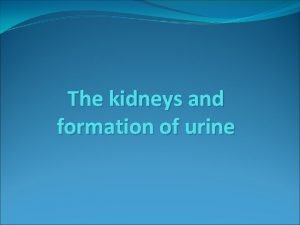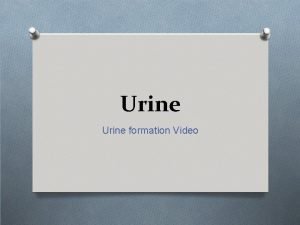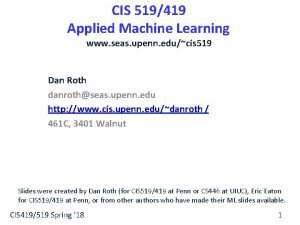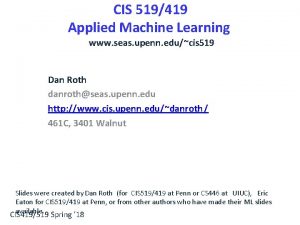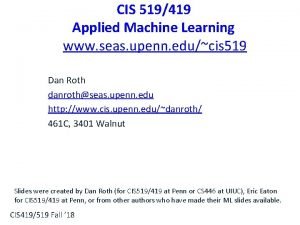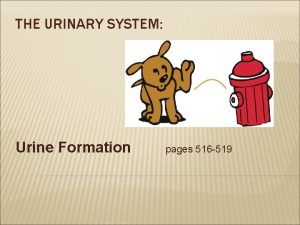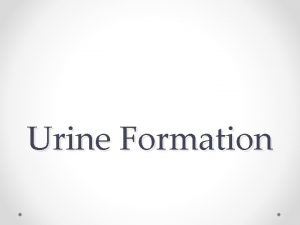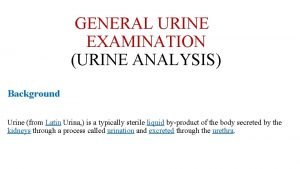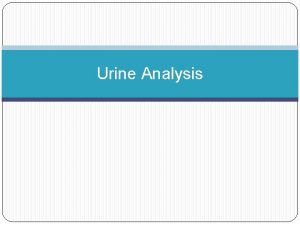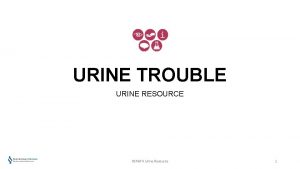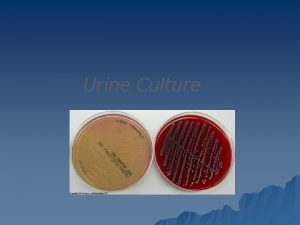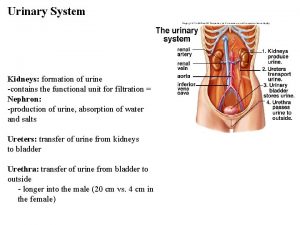THE URINARY SYSTEM Urine Formation pages 516 519












- Slides: 12

THE URINARY SYSTEM: Urine Formation pages 516 -519

© 2015 Pearson Education, Inc. URINE FORMATION The 1. 2. 3. result of three processes: Glomerular filtration Tubular reabsorption Tubular secretion

FIGURE 15. 4 THE KIDNEY DEPICTED SCHEMATICALLY AS A SINGLE LARGE, UNCOILED NEPHRON. Afferent arteriole Glomerular capillaries Efferent arteriole Cortical radiate artery 1 Glomerular capsule Rest of renal tubule containing filtrate 2 Peritubular capillary Three major renal processes: 1 Glomerular filtration: Water and solutes smaller than proteins are forced through the capillary walls and pores of the glomerular capsule into the renal tubule. 2 Tubular reabsorption: Water, glucose, amino acids, and needed ions are transported out of the filtrate into the tubule cells and then enter the capillary blood. 3 Tubular secretion: H+, K+, creatinine, and drugs are removed from the peritubular blood and secreted by the tubule cells into the filtrate. 3 To cortical radiate vein Urine

© 2015 Pearson Education, Inc. GLOMERULAR FILTRATION a nonselective passive process Driven by arterial pressure Low BP can cause filtration to slow/cease (oliguria/anuria) The glomerulus is a filter: produces the filtrate Includes water and solutes smaller than proteins Proteins and blood cells are too large collects in the glomerular capsule leaves via the renal tubule

© 2015 Pearson Education, Inc. TUBULAR REABSORPTION peritubular capillaries reabsorb useful substances: Water Glucose Amino acids Ions Mostly an active transport process; highly selective Membrane carriers exist for only specific needed molecules occurs primarily in the proximal convoluted tubule

FIGURE 15. 5 SITES OF FILTRATION, REABSORPTION, AND SECRETION IN A NEPHRON. Proximal tubule Glomerular Glucose and HCO 3− capsule Na. Cl H 2 O amino acids Distal tubule Na. Cl Blood Some drugs and poisons Filtrate H 2 O Salts (Na. Cl, etc. ) HCO 3− (bicarbonate) H+ Urea Glucose; amino acids Some drugs Reabsorption Active transport Passive transport Secretion (active transport) K+ and some drugs H+ Cortex Collecting duct Medulla Nephron loop H 2 O Na. Cl H 2 O K+ Na. Cl Urea H 2 O Urine (to renal pelvis)

© 2015 Pearson Education, Inc. FILTRATE = WASTE PRODUCTS Nitrogenous Waste: Urea—end product of protein breakdown by liver Uric acid—results from nucleic acid breakdown Creatinine—results from direct phosphorylation (creatine metabolism in muscles) Ions: amount/type varies with changes in p. H

© 2015 Pearson Education, Inc. TUBULAR SECRETION Cells of the tubules secrete excess molecules Eliminates substances not already in the filtrate drugs and excess ions Maintains Tubule cells may secrete H⁺ ions; excess K⁺ Secreted into acid-base balance of blood out of the peritubular capillaries the renal tubule

FIGURE 15. 5 SITES OF FILTRATION, REABSORPTION, AND SECRETION IN A NEPHRON. Proximal tubule Glomerular HCO 3− Glucose and capsule Na. Cl H 2 O amino acids Distal tubule Na. Cl Blood Some drugs and poisons Filtrate H 2 O Salts (Na. Cl, etc. ) HCO 3− (bicarbonate) H+ Urea Glucose; amino acids Some drugs Reabsorption Active transport Passive transport Secretion (active transport) All part of the Renal Tubule K+ and some drugs H+ Cortex Collecting duct Medulla Nephron loop H 2 O Na. Cl H 2 O K+ Na. Cl Urea H 2 O Urine (to renal pelvis)

© 2015 Pearson Education, Inc. CHARACTERISTICS OF URINE On average, 1. 0 to 1. 8 liters of urine/day Urine and filtrate are different Filtrate Not Urine still undergoes reabsorption all components of filtrate will be eliminated is what remains nitrogenous needed wastes and substances that are not

© 2015 Pearson Education, Inc. CHARACTERISTICS OF URINE Yellow color due to: the pigment urochrome (from hemoglobin breakdown) eliminated solutes Water consumption influences color: Dilute urine is a pale, straw color Sterile Nasty smell (when left standing) due to bacteria Normal p. H of around 6 (slightly acidic)

© 2015 Pearson Education, Inc. CHARACTERISTICS OF URINE Solutes normally found in urine Excess sodium and potassium ions Urea, uric acid, creatinine Ammonia Bicarbonate ions (buffer)





